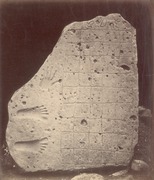Our website is made possible by displaying online advertisements to our visitors.
Please consider supporting us by disabling your ad blocker.
Astana Gede inscriptions
The Astana Gede inscriptions, also known as Kawali inscriptions, refer to six inscriptions discovered in the Kabuyutan Kawali area, Ciamis Regency, Indonesia; the main inscription (Kawali I) bears the longest scripts. All of the inscriptions were written in the Old Sundanese language and Old Sundanese script. Although the inscription does not contain chandrasangkala (chronogram), the inscription was thought to have originated from the second half of the 14th century, based on the name of the king mentioned in this inscription.
The inscription was compared to other historical sources, such as Carita Parahyangan manuscript, and it was concluded that the Kawali I inscription was meant as a sakakala or commemoration monument to honor the greatness of King Niskala Wastu Kancana, ruler of Sunda ruled from his capital in Kawali. Niskala Wastu Kancana was the sole surviving heir of King Linggabuana, and also the younger brother of Princess Dyah Pitaloka Citraresmi; both died in Bubat Majapahit in 1357.
Previous Page Next Page






